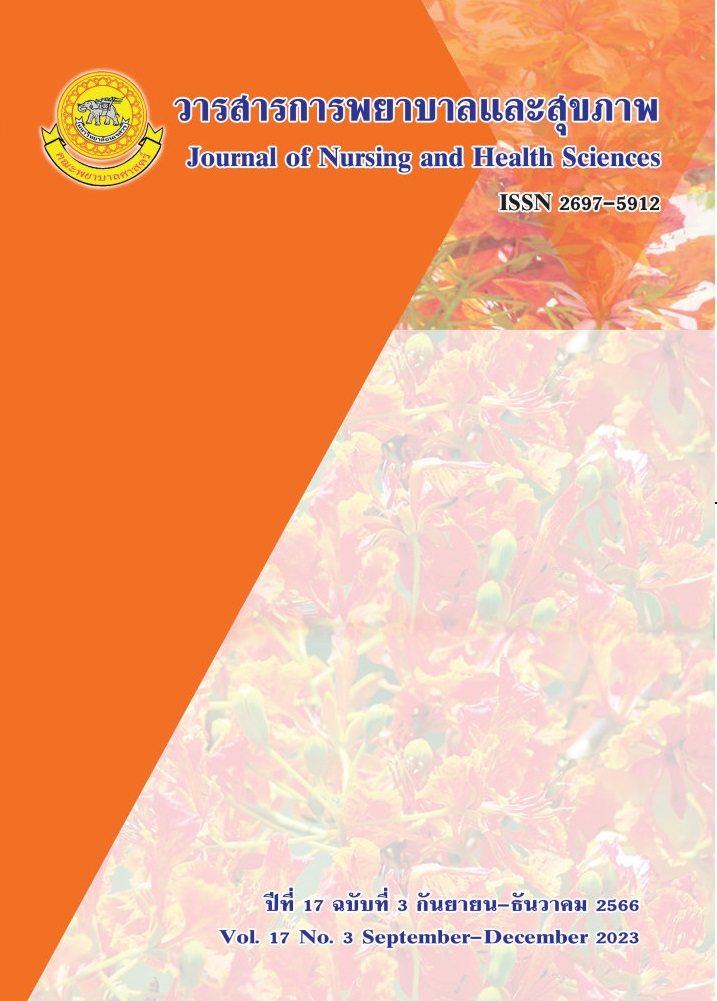Effects of the Self-Efficacy Enhancement Program with the Applied Fon-Jerng Danceon Falls Prevention Behaviors and Balance among Elderly in Phrae Province
Main Article Content
Abstract
This quasi-experimental study two groups pretest – posttest design was aimed to study the effects of a self-efficacy promotion program combined with applied dance on fall prevention behaviors balancing of the elderly in Phrae Province. The sample group studied were elderly people aged 60 years and over who were found to be at risk of falls. Using multi-stage sampling and purposive sampling and separated, 30 people were enrolled into the experimental group with a duration of 8 weeks. The tools were: 1) Fall Prevention Behavior Questionnaire in the Elderly; himself in conjunction with applied dance by applying the concept of self-efficacy theory (Bandura, 1997), with the index of conformity (IOC) equal to 0.87 - 0. 92 respectively. Paired t-test and independent t-test statistics were analyzed. Average score of balance of the elderly after the experimental group There was a statistically significant difference at the .001 level and the comparison of differences after the experiment. between the experimental group and the control group It was found that the mean score of fall prevention behavior and the mean score of balance of the elderly in the experimental group was significantly better than the control group (p< .001). and It was found that the mean score of fall prevention behavior and the mean score of balance of the elderly in the experimental group was better than the control group. There was a statistically significant difference at the .001 level. 001 and the comparison results after the experiment. between the experimental group and the control group It was found that the mean score of fall prevention behavior and the mean scores of balances in the elderly of the experimental group were better than the control group. There was a statistically significant difference at the .001 level.
The results of this study can promote fall prevention behavior and the improve balance among elderly. To gain confidence in performing activities and practicing doing it yourself continuously.
Article Details

This work is licensed under a Creative Commons Attribution-NonCommercial-NoDerivatives 4.0 International License.
References
Anothaisinthavee, T., Thammakraisorn, S., & Srisuwan,
P. (2022, August 22). Complete report systematic
literature review Measures to prevent falls in
the elderly. https://www.hitap.net/research/24183.
Areeruk, N., Rojpaisarnkit, K., & Wongprasit, N. (2015).
The Effects of an Integrated Exercise Program
on the Health Conditions, Physical Fitness,
and Self-Efficacy Expectations of the Elderly.
The Pubic Health Journal of Burapha university.
(2): 66-76. [In Thai].
Bandura, A. (1997). Self-Efficacy The Exercise of
control. New York: W.H. Freeman and company.
Bureau of Non-Communicable Diseases, Department of
Disease Control, Ministry of Public Health.
(2016). Guidelines for prevention operations.
Injuries by health facilities. Nonthaburi: Motion
Arts. [In Thai].
Cohen J., (1988). Statistical power analysis for
the behavioral sciences. 2nd ed. Hillsdale, NJ:
Lawrence Erlbaum Associates, Publishers
Dadgari, A., Hamid, A. T., Hakim, N. M., Mousavi, A.
S., Dadvar, L., Mohammadi, M., & Amerian, N.
(2015). The role of self-efficacy on fear of falls
and fall among elderly community dwellers in
Shahroud, Iran. Nurs Pract Today, 2(3): 112-120.
Department of Older Persons. (2021). Statistics of
the elderly. Accessed on November 22. https://
www.dop.go.th/download/knowledge/th166382
-1747_1.pdf
Flight, L., & Julious, S. A. (2016). Practical guide to
sample size calculations: superiority trials.
Pharmaceutical Statistics, 15(1), 75-79.https://
doi.org/10.1002/pst.1718
Glass, G.V. (1976). Primary Secondary and Meta -analysis
of Research. Education Research 10, 3-8. https://
www.jameslindlibrary.org/glass-gv-1976/
Institute of Geriatric Medicine. (2019). Clinical practice
guideline for the prevention and assessment of
falls in the elderly. Nonthaburi, Department of
Medical Service.
Jo, H.-E. & Kim, M. J. (2017, June 30). Effects of a Fall
Prevention Program on Physical Fitness, Fall
Efficacy and Fall Prevention Behavior among
Community-dwelling Older Adults. The Korean
Journal of Rehabilitation Nursing. The Korean
Journal of Rehabilitation Nursing. http://doi.org/
7587/kjrehn.2017.22
Na Nakhon, W. (2018). Effects of Applied FON-JERNG
Exercise Dance Program on Physical Fitness of
Elderly in The Sriwiang Village, Wiang Chai
District, Chiang Rai Province. https://so03.tcithaijo.org/index.php/tahper/article/view/250426/
Nooake, S. (2018). Factors Influencing for Falls of
In-Patients at a Regional Hospital in Bangkok
Metropolis .https://he01.tci-thaijo.org/index.php/
JNAE/article/view/245333/166541 [In Thai].
Pankong, O., and Sangournpak, O. (2012). Effect Rum
Thai Prayouk on Muscular Strength, Activity of
Daily Living and Well-being of Older Persons.
Nursing Journal, 39: 118-127. [In Thai].
Phimsan, C., Sakulkim, S., Seubsui, N., Lodseeda, C., &
Seesod, S. (2019). Effects of Shoulder Exercise
Program on Exercise Behavior and Physical of
Shoulder in Elderly, Bang Khun Si District,
Bangkok Noi, Bangkok. Advanced Science
Journal. 19(2): 27-43. [In Thai].
Phongpaew, S. (2013). Predicting Factors for Fall
Prevention Behaviors in the Elderly, Nonthaburi
Province.https://dric.nrct.go.th/Search/Search
Detail/289029. [In Thai].
Phrae Provincial Public Health Office Ministry of
Public Health. (2021). The number of elderly
people with falls.Fall and hip and leg injuries in
Phrae Province in 2019-2020. Accessed on 15
March 2021. [In Thai].
Prommapong, N. (2018). Factors related to fear of
falling among older adult patient. Master's
thesis, Faculty of Nursing-Science, Burapha
University. [In Thai]
Soontorntai, P., Phakdepiboon, T., Sanjaroensuttikul,
N., & Sinithanon, R. (2016). Efficacy of Beguine
Dance on Balance in Elderly Thais with a
History of Fall. J Thai Rehabil Med, 26(2):
-66. [In Thai].
Strategy and Planning Division. (2021, January 15).
Situations of falls, year 2018. Retrieved 11
June 2021 from https://ddc.moph.go.th/uploads/
files/1660320210115094236.pdf [In Thai].
Tantiwiboonchai, N. (2010). Effects of Muay Thai
Aridic and Resistant band training with Vitamin
D and Calcium supplement on Biochemical bone
markers Health-Related Physical fitness and
balance on the elderly women. Retrieved 13
November 2022 from http://ortho.md.chula.ac.th/
LoadUnit/ index.php/2013-04-29-08-59-27/viewsubmission/388.html [In Thai].
Thagjirawattana, M., and Vudhirorarit, S. (2019).
Predictive factors of fear of falling among
elderly. Journal of Health Science Rescarch,
(2), 30-40. [In Thai].
Tosem, S. (2020). Effects of a Physical Activity
Promoting Program on Self-Efficacy for
Physical Activity, the Severity of Knee Osteoarthritis, and Balance among Persons with Knee
Osteoarthritis. Rama Nurs J. 26(2). 172-187.
World Health Organization. (2007). WHO global
report on falls prevention in olderage. Retrieved
February 2021 from https://extranet.who.int/
agefriendlyworld/wp-content/uploads/2014/06/
WHo-Global-report-on-falls-prevention-in-olderage.pdf


